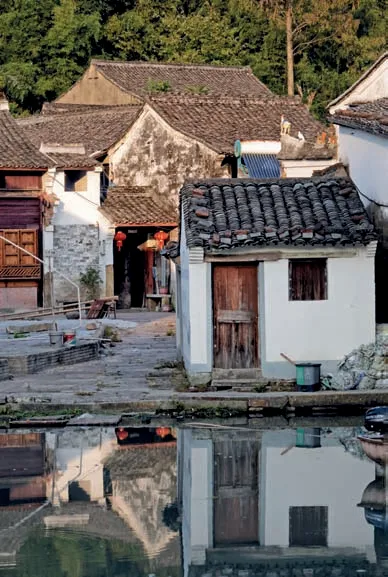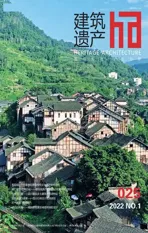沃菲尔德风土图记 XXV聚落中的空间方言
2022-06-24何依孔惟洁张乐天张再红朱亚云译校
何依 孔惟洁 张乐天 张再红译 朱亚云译校
什么是风土?和辻哲郎在《风土》一书中将其定义为“土地的气候、气象、地质、地貌、地形、景观等的总称”[1]1,并从这个观点出发得出了住居形式与风土息息相关的结论。[1]8藤井明则进一步证明了风土的社会性:风土只不过是作为一个已知的条件而已,当建筑物作为一种形象“事物”出现在聚落内部时,还需考虑聚落共同体民意的空间概念和意识,这些绝不可能被风土直接表现出来,创造者的意图是通过特定形式才能被表现。[2]188综合而论,风土的烙印使一方土地拥有各自空间的方言,其封闭在内部所形成的世界观,投射到聚落的物态空间,使人们在体验中能够获得直觉的感受。
方言俗称地方话,是语言的地方变体,随着氏族大规模向远方迁移,与迁居地的本土文化进行融合,逐渐异质并分化,产生了分布在不同地域上的方言。作为局部地区通行的语言,形成方言的因素很多,但山川河流等地理环境的阻隔,是方言在漫长演变过程中得以保存的重要条件。因此,一种方言往往对应着一个地理单元。农耕社会的乡村聚落通过“定居”使人与土地锚固在一起,在工业化带动城市化之前,标准化建造方式对聚落的影响较小,依赖一定范围内的有限资源,聚落形态在不同的地理单元形成了差异。从语言学的概念出发,可将聚落中的房子视作一种语词,语词相互勾连形成语句,不同的勾连方式创造出语句不同的意义。
引申到聚落,空间意义并非来自其中的某一栋房子,而是房子之间相互依存所形成的一种整体关系,它是经过岁月的长久累积酝酿而成的。所谓“空间方言”,对应着某一个特定的地理单元,是一种固定的建筑组合形式,作为一个有意义的“语句”出现在聚落内部,因相同或相似组合形式的不断重复,使聚落表现出鲜明的地域辨识度。空间方言作为风土的建筑响应,是栖居与自然环境协作的结果,更是作为社会制度被表现出来。正如藤井明在《聚落探访》中所言:“共同体依靠制度得以存续。制度作为体系渗透到聚落的空间中。……成为景观中可以看到的几何学构图。”[2]20
空间方言作为地理环境的产物,需要在不同的地域范围内进行解释。初识乡村聚落是在太行山南麓的泽州盆地,乡村是“院”的聚合,院套院,院接院,院落成为家族实力的度量单位,数不清的院落在图底关系中很容易识别。东西南北四座建筑,围合成一个闭合空间,四合院无疑是中国传统民居的基本原型,从语言学的视角看,就是聚落中的标准语言即“官话”,简单易懂,作为原型在北方地区差异不大。然而,江南地区的地形多变,聚落的空间方言也随之繁多,并因各种文化交融而表达隐晦,但万变不离其“宗”。这是源于中国历史上北方士族大规模南迁,为求生存形成的同宗同族比屋而居的聚落共同体。祖先的在场性,有效地预防内部的瓦解,抵御外敌的侵入,共同抗击自然灾害,成为共同体在长时段中得以存续的重要条件。在此,舍去风土语境中的自然地理环境及区域社会成因,通过一座内湖渔村的案例研究,去管窥宗族规定下宁波东钱湖乡村聚落的“方言小片”。
陶公山是东钱湖西岸的一座小孤山,天台山在此落脉,山下连绵分布着首尾相接的建设、陶公、利民三个村庄,共称陶公山三村。先民们多因避战乱、躲仇家而陆续迁入,以捕鱼为生,随着人口的增加,窘于土地资源,聚落在山湖之间加密式发展,最终形成了“一条长街串十姓,百条短巷连山湖”的格局。自然环境与人居社会高度融合所散发出的强大能量,使聚落形态极具个性,引发我们持续了十余年的探索。
长街是十姓宗族的公共空间。一条长街从村头至村尾串联着十个家族姓氏,作为各族之间唯一的纽带,长街具有突出的公共属性,派生出中心与边界、个性与共性、交通与交往、市集与祭祀等诸多意义。行走在长街时,象征宗族制度的大祠堂与小“堂前”,将各自的权力投射在长街,一段段街道好似在讲述着一部部家族史。经过岁月冲刷形成的宗族制度,被固化为可感知的空间图式。
短巷是渔业捕捞的生产资料。作为一座业缘型的内湖渔村,埠头是泊船必备的码头,每条短巷就是一个生产单元。基于渔业岸线资源的博弈,为满足“渔者有其岸”的作业需求,最大化分配了泊船岸线,长短不一的巷道分割出一个个生产生活单元,数以百计的巷道显示出聚落内部高度的同质化。最吸引我们的是,每条通向湖畔的巷道,都有一条渔船泊在尽头,使得这座聚落如此与众不同。
回到空间方言,在“经世致用”思想盛行的浙东地区,宗族内部形成了宗、房两级制的组织构架,其中血缘关系更为紧密的“房族”具有独立行事能力,并以一个居住单元的形式在聚落中分区而制。“堂前”是宁波方言,又称堂沿或堂檐,是房族的象征建筑,立于院落的中心,前后有明堂,左右置排屋,组合成一个“H”型的堂前院落。这一空间方言在陶公山自然场地的诱发下,形成了巷头立堂前,巷尾设埠头,两侧排屋从山脚延伸到湖畔的“巷道式”堂前院落。其中,房族内部的巷道为“正巷”,房族之间的巷道为“背巷”。经过数百年的洗炼,“风土”早渗透到聚落内部,使其成为一个完整的自律系统而运转。的确如此,在风土环境的制约下,“人们越是在残酷的自然条件下,创造力发挥得越是淋漓尽致,建造出的聚落和住居空间组合越是巧妙无比”。[2]195
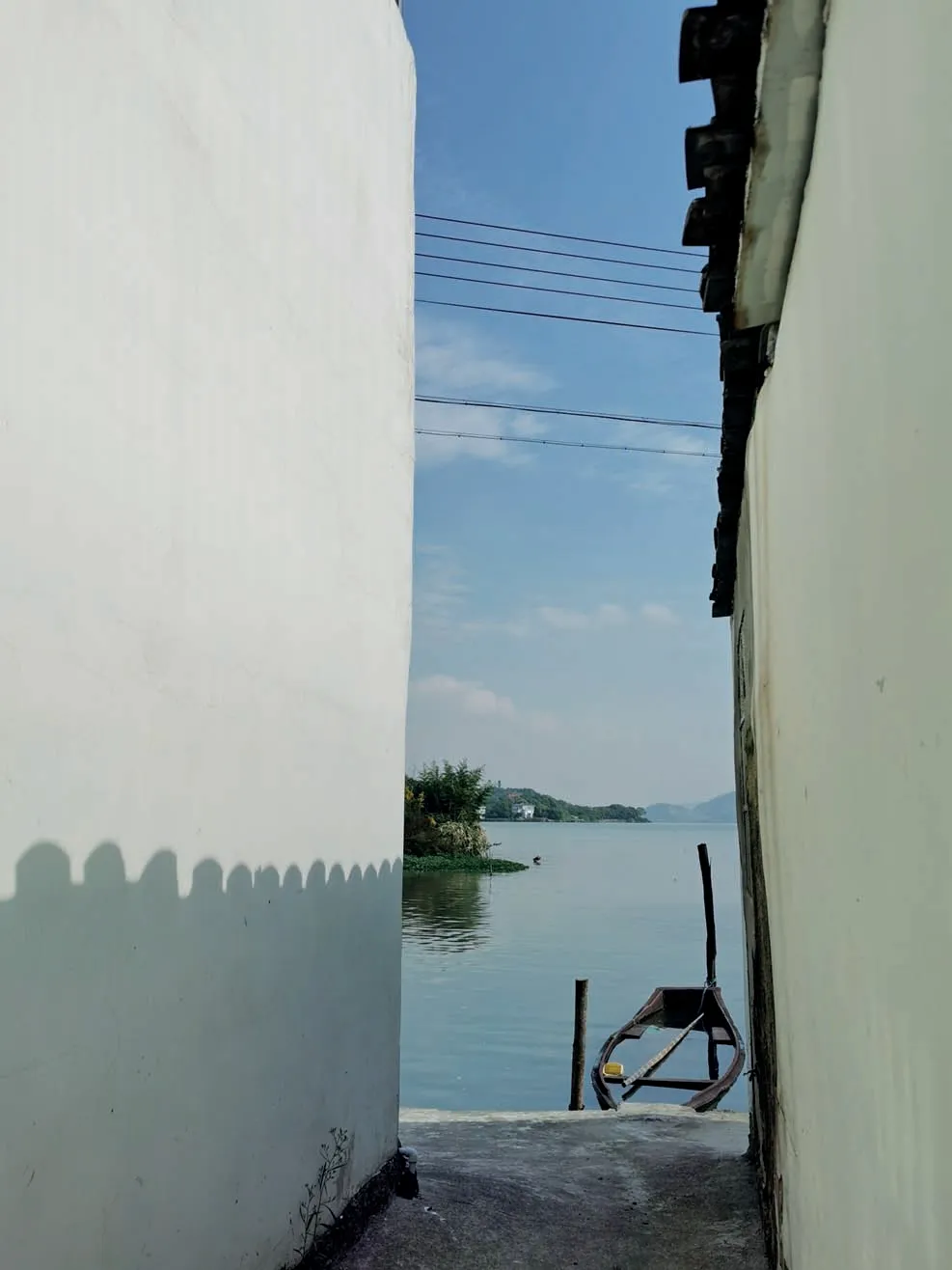
静谧湖岸,浅舟摇曳,高高低低的立杆矗立水面,长长短短的钓竿堆叠船上,歪歪斜斜的埠头伸向水中,家家户户的渔船泊在门外,清晨的渔村只听见湖水拍岸的声音。
By the tranquil lakeshore, a small boat gently sways. A pile of long and short fishing rods lies inside, and poles of varying lengths stand in the water. Winding jetties stretch out into the lake, to which every family’s fishing boats are moored. In the early morning, nothing but the sound of the water caressing the shore can be heard.
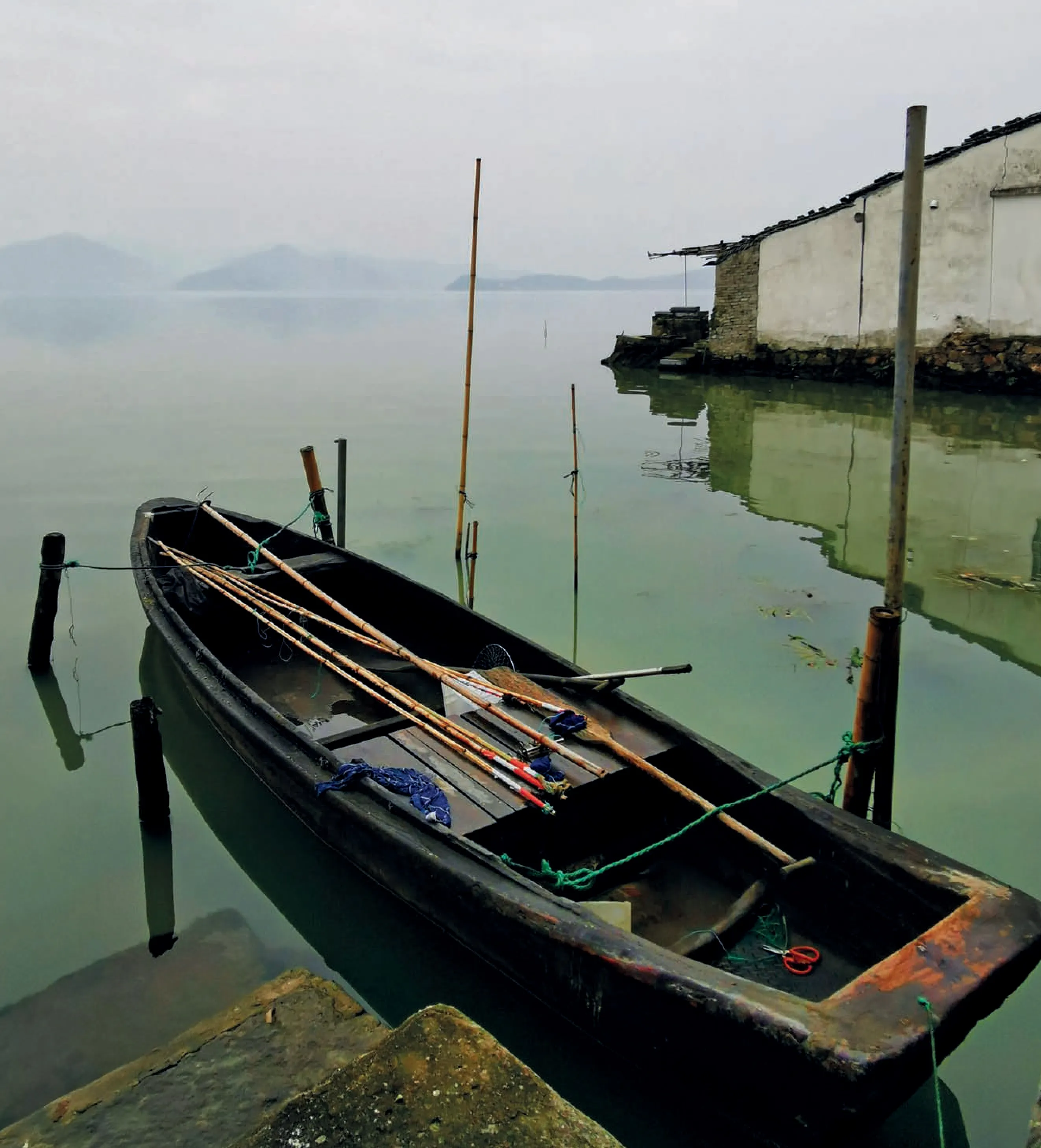
晴朗的白昼,湖面上总能见到散落的捕捞小舟。渔民们在日出时分就进湖,午后才返回。对陶公山的渔民来说,天台山下的东钱湖与其说是他们的猎场,不如说是他们的田地。宛如明镜的湖面上,每隔一段距离就能看到稳插湖底的竹竿,这些竹竿标识出各家的捕捞地界,渔民们在各自的水域内放置箱笼沉入湖下。浩瀚的水面,只有他们自己知道这湖中的秘密地图。
按照渔民的惯例,每年下半年有一个月的休渔时间,防止过度捕捞,使鱼类资源可充分恢复,从而保证过年时各家的餐桌上都有湖鲜可以享用。这种在岁月沉淀中流传至今的约定,蕴藏着陶公山渔民知天时、得地利、谋人和的地方智慧。
On a clear day, small fishing boats are scattered on the lake. Fishermen enter the lake at sunrise and return in the afternoon. For them, the Dongqian Lake is not so much the fishing ground as the fields they cultivate. On the mirror-like surface of the lake, one can see at regular intervals the bamboo poles, driven securely into the bottom of the lake and marking the boundary of each family’s fishing area. The fishermen sink fish traps in their respective waters. Only they themselves know the secret map of the lake beneath the spacious waters.
According to conventional practice, fishermen usually enjoy a one-month fishing hiatus in the second half of each year, to avoid overfishing and to enable fish stocks to sufficiently recover, ensuring that every household has abundant freshwater fish to enjoy during the Chinese New Year.This agreement has been passed down for generations, embodying the local wisdom of knowing favorable timing, obtaining geographic advantages,and living in harmony.
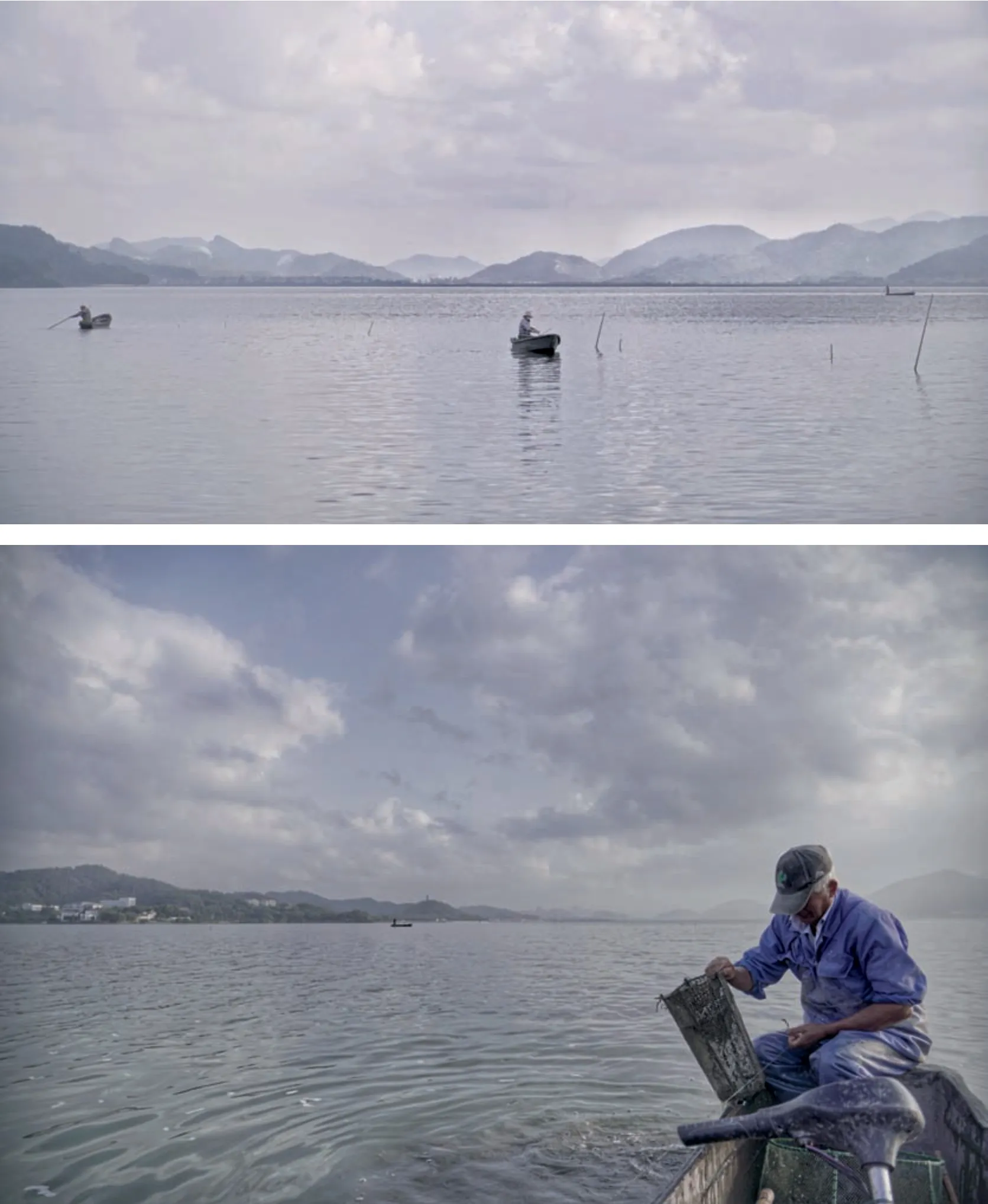
陶公山北麓的地形狭窄,因此有许多挨着湖边的院子。院子在临水一侧开了一扇小门,门外连接着埠头,埠头延伸向湖面。
这原本是为方便临水的居民在自家房后进行渔业交易和生活取水,却无意间营造了一种独特的景观——推开大门透过院落便能看见天水相连的东钱湖,院外来来往往的船只,掀起阵阵波浪拍击埠头。
一扇小门隔着两重天地,眼前广阔的湖山光景,仿佛是打开的“楚门的世界”。
The northern foot of the Taogong Mountain is narrow and confined, so many courtyards are built on the verge of the lake, each with a small door opening on to the water. Outside the door is a jetty jutting out into the lake.
This was originally meant to facilitate transactions of fish products and to provide convenience for domestic use of water right outside the residents’ own houses, but it unexpectedly created a unique landscape; when the door is open, from the courtyard one can see the Dongqian Lake where the sky and the water meet. Outside the courtyard, boats come and go, leaving waves dashing against the jetty.
The small door separates two different worlds, unfolding a vast landscape of lakes and mountains before our eyes, as if it were a real The Truman Show.
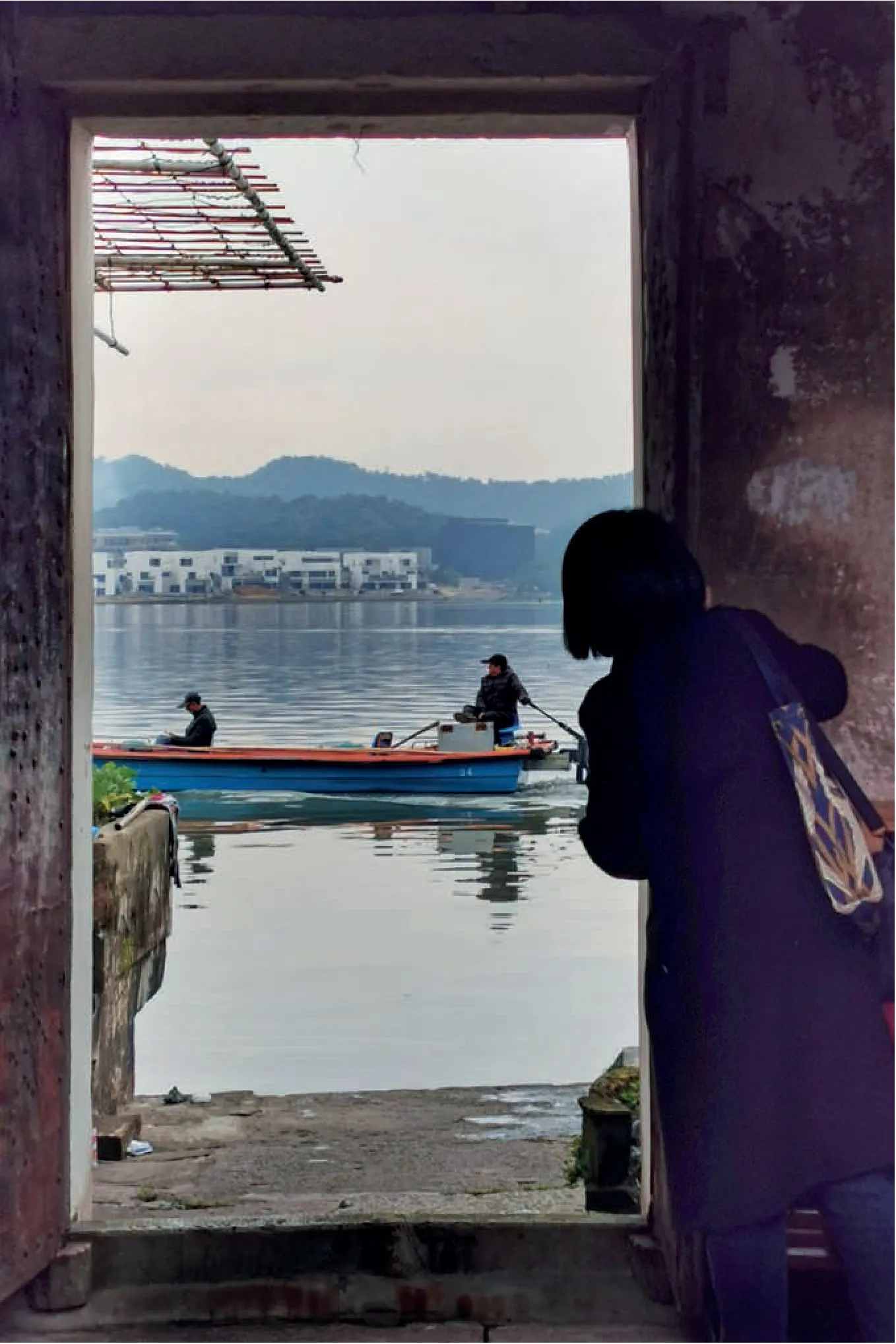

对于陶公山这类居住密度较高的渔村,田地极为稀缺。人们会利用山脚水畔、房前屋后有土壤的地方来种植蔬菜,丰富已摆满鱼虾水产的餐桌。
那些湖边的宅院往往会拥有一处自家的埠头,这一小块岸边的空地,有着多样的功能:是归航人回家的玄关,是下厨人加工食材的厨房,也是农耕理想下现实中的局促田园。
人们会利用各式容器固土种植。泡沫纸箱里冒出的小葱,废弃浴缸中栽培的鸡毛菜,就连轮胎内也能长出鲜艳的花朵。
本着“不浪费”的原则,在“再利用”中创造出了色彩丰富的生活世界。
For the highly dense fishing villages like the Taogong Mountain, fields are scarce. People make full use of every inch of land, including foothills, lakeshore, and the front and back of the houses, to grow vegetables, as supplementary to the mainstays on the dining table such as fish and prawns. Those who live by the lake usually have a jetty of their own. This small piece of vacant lot on the lakeside has various functions: a gateway to welcome the fisherman home, a kitchen where the housewives cook, and a makeshift vegetable plot to fulfil pastoral dreams. People use all kinds of containers to consolidate soil for gardening. For example, spring onions grow in a carton, green vegetables flourish in an abandoned bathtub, and flowers blossom inside a tire. Based on the principle of ‘no waste’, recycling has helped to create a colourful and enriching life.

陶公山的村民们每天日出而作,日落而息。清晨的湖畔,村民们世世代代忙碌的身影,谱写了一首劳作与时日的长歌。人们享受着自然造物的馈赠。捕捞上岸的鱼虾,经历时间的风干成为餐桌上的美味,年复一年养育着陶公山,生生不息、血脉相传,也让这座城市边缘的村落充满了活力与希望。
Every day the villagers of the Taogong Mountain work at sunrise and rest at sunset. Every early morning, the lakeshore witnesses the diligence of the villagers for generations, and their labour and daily life become part of the lake scenery. People enjoy the gifts from nature. After being wind-dried, fish and prawns become delicacy on the table, nourishing the Taogong natives year after year, keeping its tradition alive and making the villages abutting the city full of vitality and hope.
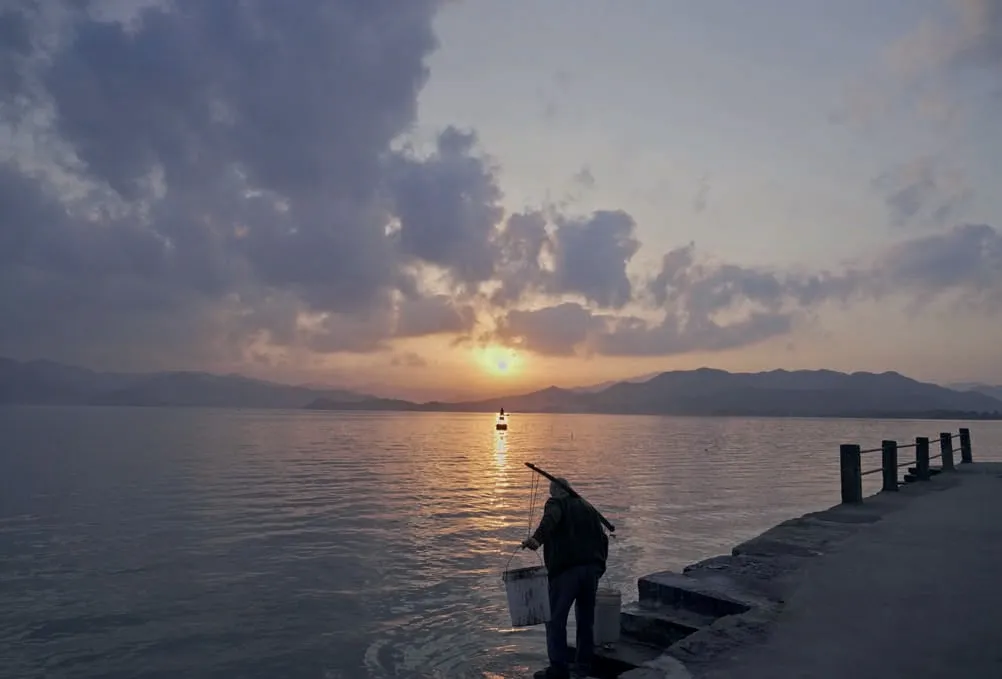

陶公山原本是东钱湖西岸一座幽闭的孤岛,与世隔绝。
山下的生活很简单,种菜捕鱼,自给自足,每天只需与山和湖对话。
山下的生活很充实,一日三餐做得很认真,可以让人们忙活一整天。
山下的生活也很慢,每一条鱼都平静地晒着太阳,耐心地等待时间的发酵,一切的一切都是自然而然的结果。
岛外车水马龙,人声鼎沸。但陶公山却日复一日过着自己的生活,沉静如水。
The Taogong Mountain was an isolated island on the west bank of the Dongqian Lake, secluded from rest of the world.
People live a simple, self-sufficient life. They grow vegetables, catch fish, and converse with the mountains and lakes every day.They live a fulfilling life. The three carefully-prepared meals keep them occupied for a whole day.
They also live a slow life. Dried Fish bask quietly in the sun as time patiently ticks away, and everything will come to fruition naturally.
The outside world is overcrowded, full of hustle and bustle. Yet in the Taogong Mountain everyday life has its own rhythm, tranquil as still water.
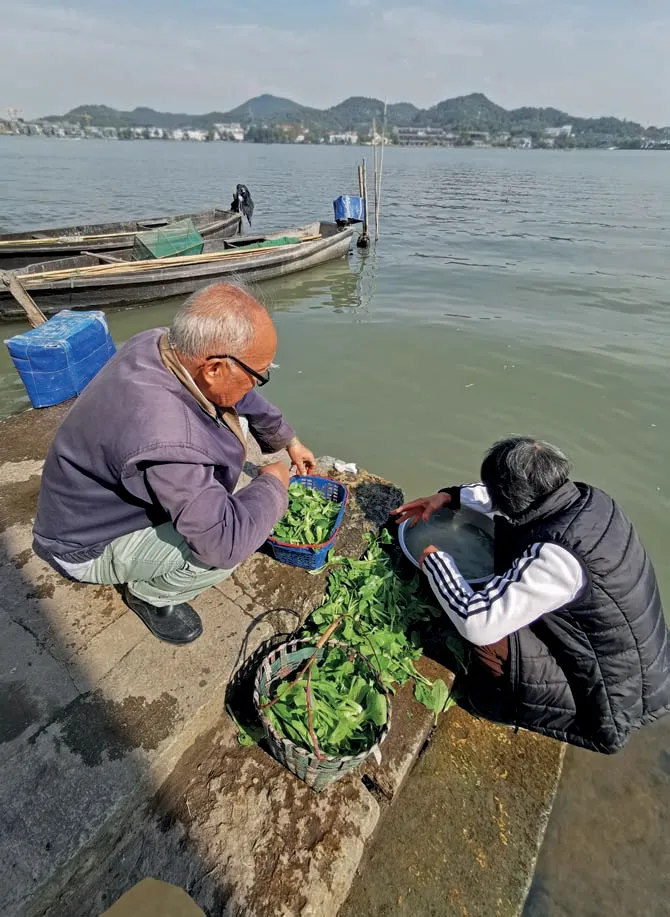
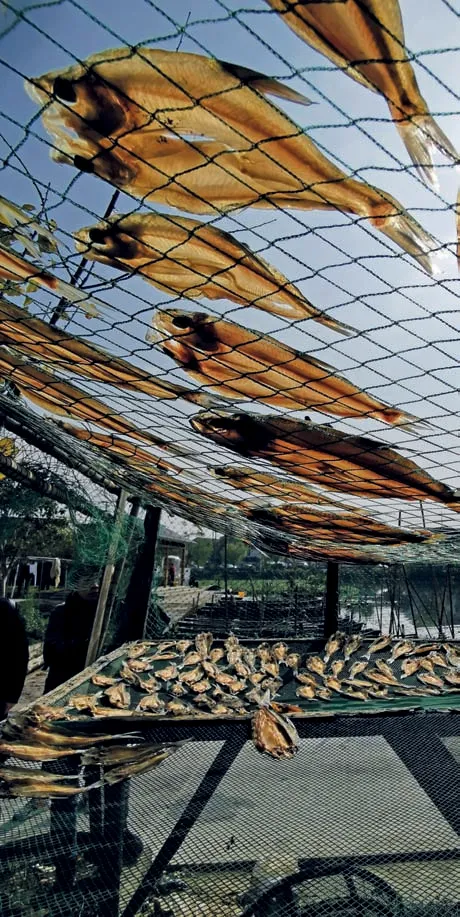
陶公山迎着东钱湖的风浪。为了宜居更为了渔船停靠,先民们环岛筑起一段段防浪堤,堤上种柳树,于是就有了一个雅名:柳汀。
柳汀在村庄和大湖之间形成了一条内河,内河风平浪静,每隔一段就有一棵临水的大树撑起一片天空,树下是渔船泊岸的埠头,也是村民浣洗的台阶,偶尔还有些湖鲜在此交易。
在一个熟人社会里,如果一座祠堂建构起一个正规性的集体身份,那么一颗大树就聚拢了另一个非正规的集体身份。在家家户户都用上自来水的今天,大树与埠头的意义早已超越了生产生活,更多的是为人们提供了一处处相遇之地。
The Taogong Mountain bore the brunt of the storms and waves of the Dongqian Lake. In order to create a livable environment, and more importantly, to provide a safe haven for the fishing boats, the early settlers built a number of breakwaters around the island, and planted weeping willows on them, thereby giving them an elegant name Liuting (Willow Embankment),
The Willow Embankment forms a calm buffer river between the villages and the Dongqian Lake. At intervals big trees, forming a canopy,overlook the river. Under each tree lies a jetty for docking fishing boats, also serving as stairs for the villagers to wash clothes, and occasionally as a market for fish trading.
In a society made of acquaintances, if an ancestral hall is seen as a site to build a formal collective identity, a large tree would attract an informal community group. Today, when all the households have access to tap water, the trees and the jetties have mostly become the places for social meetings and community activities, rather than the means of production.
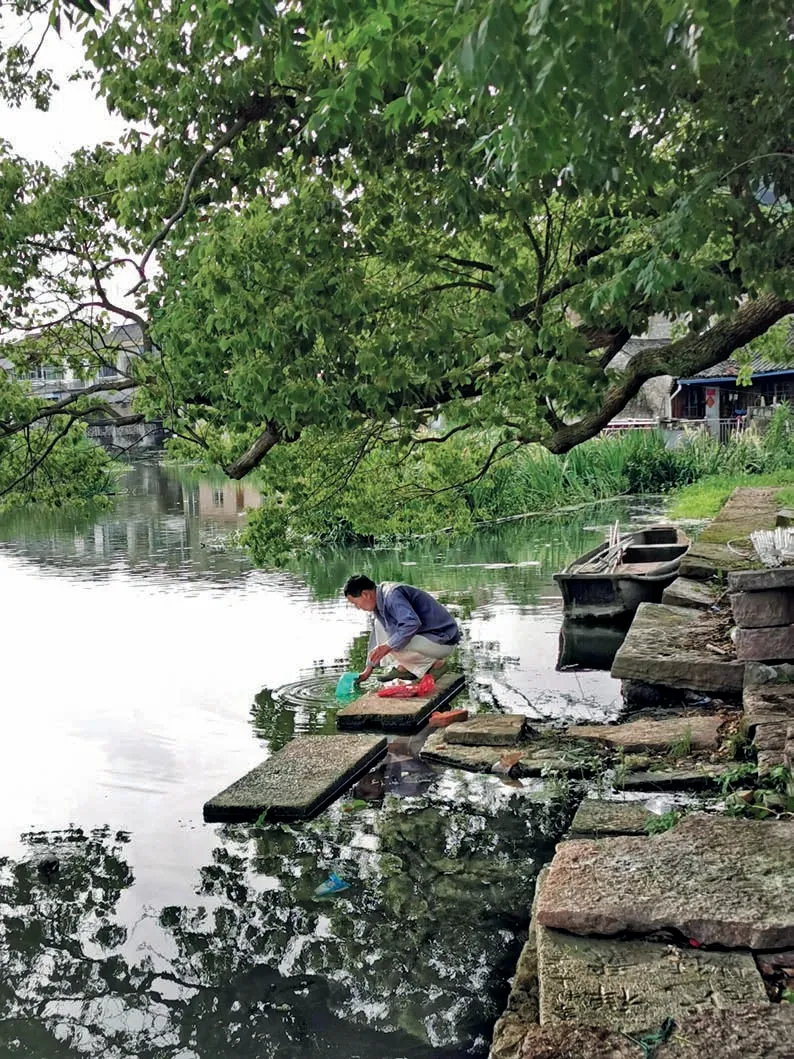
陶公山村依山傍水,相对水岸人家的规整和紧凑,那些座落在山脚下的民居则因为没有了岸线的束缚,反倒显得松散自如。
这座山下的房屋,山林如屏,浑然一体,屋外的青石板连着山脚,形成一条独特的边界,身在其中,分不清是在院内还是在林中。
人居智慧来自于栖居与自然的协作,山南充足的阳光,屋外宽敞的台地,居高的地势,都成为这些山居长久无患的原由。
The villages of the Taogong Mountain sit between the mountains and rivers. Compared with the residents living on the waterfront where life is more disciplined and busier, those dwelling at the foot of the mountain are freer and more relaxed, without the shackles of the shoreline.
This house is fully integrated with the woods, which serve as a natural defence. The bluestone tiles in the courtyard lead to the foot of the mountain and form such a distinctive boundary that it is difficult to distinguish the courtyard from the woods.
The wisdom of human settlement originates from the interaction between human habitation and nature. The abundant sunshine on the southern side of the mountain, the spacious terrace outside the house and the high terrain, have all contributed to the enduring liveability of the mountain dwellings.
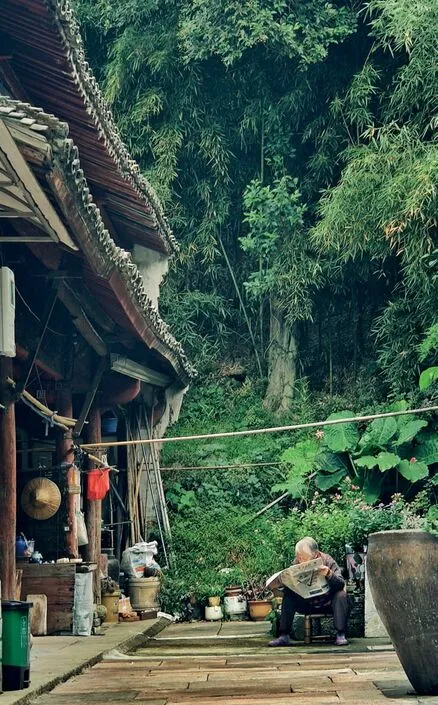
晨晖之下,山墙的轮廓愈加清晰,陶公山村第五立面是生动又含有秩序的。在个体建造的过程中,同一个匠系的民居具有一个较为固定的屋架原型,以某种相似的形态重复着,又自发地遵循着地形秩序,起伏的轮廓顺着堂弄的弧线蜿蜒,纵横的屋脊沿着山势重叠。
In the morning glow, the outline of the gable is becoming clearer and the bird-eye view of the Taogong Mountain looks both vivid and orderly.In the process of construction, houses designed and built by the same craftsmanship share relatively similar wheel-like roof truss, but in slightly varied forms, with perfect integration into the terrain. Its undulating outline winds along the arc of the lanes, and the vertical and horizontal roof ridges overlap each other following the contours of the mountain.
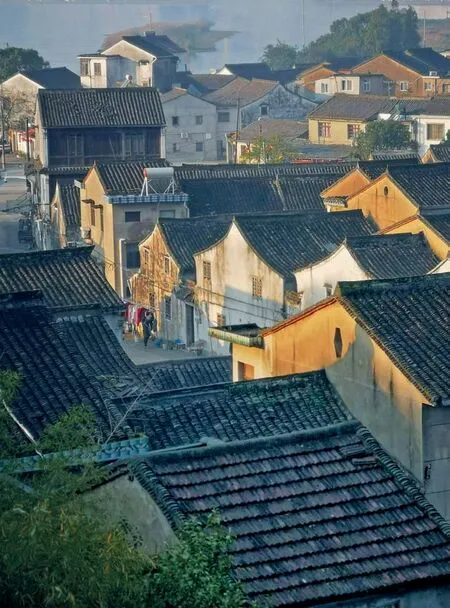
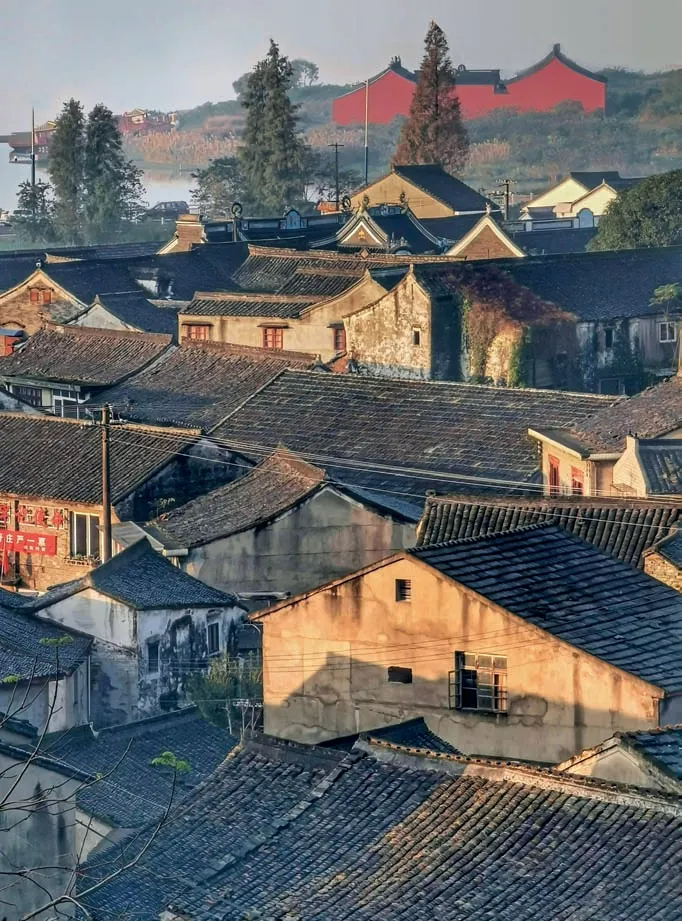
陶公山下的村落呈梳状结构,百条短巷连山接湖,密密麻麻的巷道是这座渔村最具特征的空间形式,其中就有正巷和背巷。
正巷原本是一个房族的院落,因土地紧缺而压缩成巷,两侧房屋相对而立,巷头大多对着“堂前”,是族人生活的场所;背巷是两个房族的分界,两侧房屋相背而立,多有常年不开的后门,也是山上排水入湖的通道,因而地面铺满绿色的苔藓。这种有序的宽街窄巷、横街纵巷,成为所有“码头聚落”的一种空间模式语言。
The villages at the Taogong Mountain are a comb-like structure, with more than a hundred short lanes connecting the mountains to the lake.The densely packed lanes are a distinctive spatial feature of the fishing villages, comprising the main lanes and the back lanes.
The main lane was originally a courtyard of a family branch, which has been converted into lanes due to the shortage of land. Houses lining on both sides of the main lane face each other, and at the front entrance of the lane usually stands the family ritual hall, in which the family live. The back lane serves as a dividing line between two family branches. The houses on both sides lie back to back, with their rear doors locked all the year round. The back lanes are also the channels to drain water from the mountain into the lake; consequently, its ground is covered with green moss.These well-organised wide and narrow lanes, stretching horizontally and vertically in an orderly fashion, become a model of spatial language for all the ‘jetty settlements’.

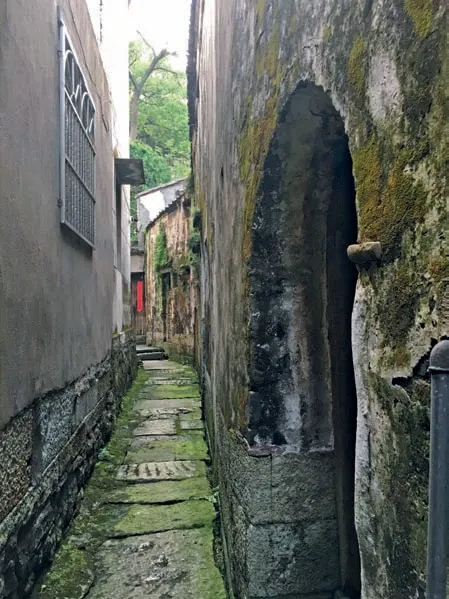
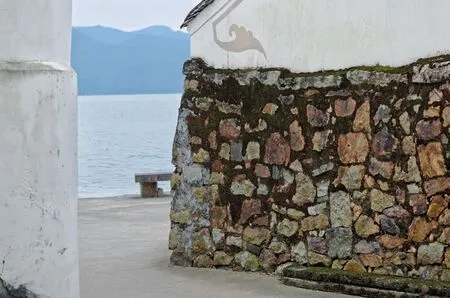
从空中俯瞰陶公山村,建筑高密度排列而形成的肌理环绕着陶公山铺展开来,从山脚到湖岸如经络般串接了百条巷子,每一组房屋都像是从土地里生长出来的斑块,每一个斑块都是人们的建造行为对自然的回应。
同时,在高度相似的肌理中也隐含着自然和社会两类单元组织:自然单元建立在地形、气候与生产活动基础上,反映了适居与宜业的内在规律;社会单元建立在宗族社会基础上,是社会组织外在的空间秩序。
An aerial view reveals that the high-density buildings spread out around the Taogong Mountain. From the foot of the mountain to the lakeshore,hundreds of lanes are connected into the architecture like energy channels. Each group of the houses forms a land patch, symbolising how human construction responds to the nature.
At the same time, the highly similar style of the architecture implies two types of organisational units: nature and society. The natural unit springs from terrain, climate and production activities, and reflects the inherent laws of liveability, workability and sustainability; the social unit is based on the clan society and is the external spatial order under the social organisation.
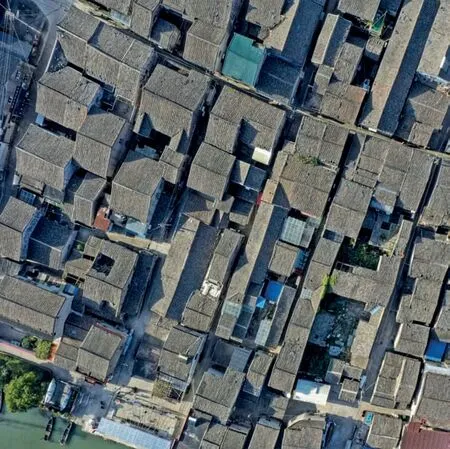
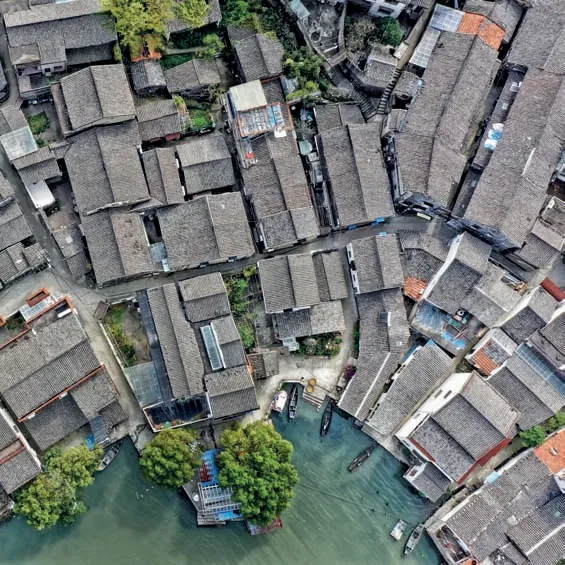
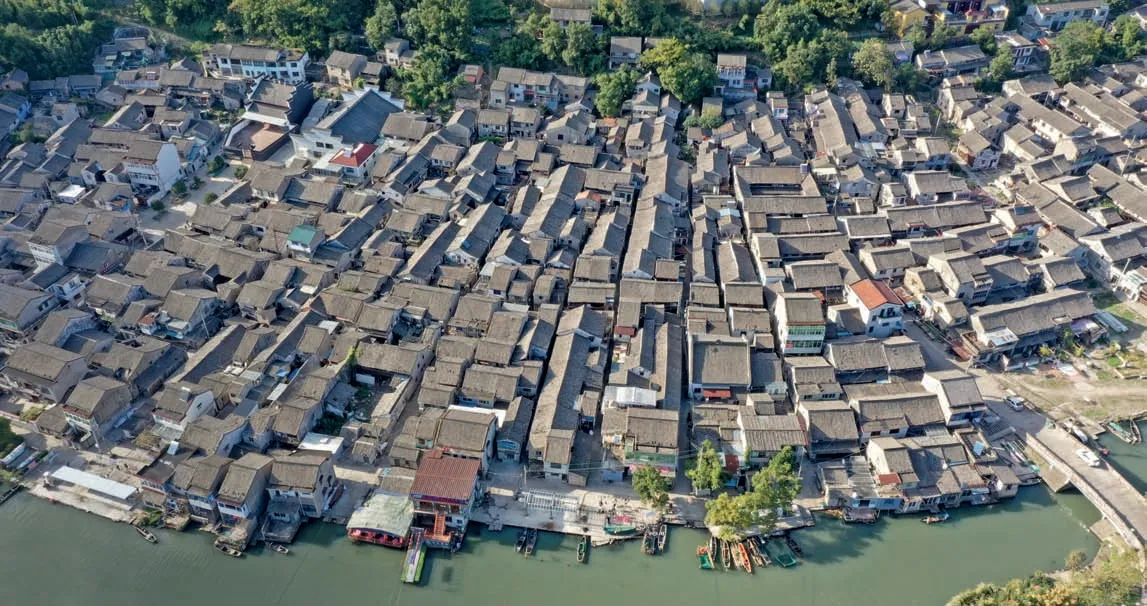
一年一度“菩萨出殿”的游神仪式,是平淡乡村生活中最鲜亮的一抹颜色。历史上造福百姓的官吏,西晋的鲍盖、唐代的裴肃、宋代的王安石、胡榘等纷纷出殿,接受民众的拜谒。人们将菩萨从社庙中抬出,请到各族的祠堂中“做客”,各个社群身着不同色彩的服饰进行表演,配以鼓乐锣镲队伍为仪仗,热闹喧嚣从清晨延续到正午,持续一周的做戏敬神才刚刚开始。
The annual ritual of the ‘Procession of Gods’ is the most colourful event in the otherwise quiet village life. Villagers pay respect to the ancient officials who had benefited them, such as Bao Gai (?–316 CE) in the Western Jin Dynasty, Pei Su (?–802 CE) in the Tang Dynasty, Wang Anshi(1021–1086) and Hu Ju (1163–1244) in the Song Dynasty. They carry the gods out of the community shrine and invite them to their respective ancestral halls as honoured guests. Various communities in different colours of costumes perform to the accompaniment of drums, gongs, and cymbals. The lively celebration continues from early morning till noon, and it heralds only the beginning of the week-long theatre performance and worship ceremony.

又回到了巷口这一“窗口”。
从对岸越过内河望村,每一个巷口都能窥见不一样的亲水“空间语言”,这是漫长的湖畔生活生长形成的。朱家祠堂正对着的埠头上,存放渔具的小房子静伫岸边,与祠堂一前一后高低呼应。天材山头下的埠头是用于停船的小港,房屋层层叠叠向上,从水边生长到山头。建设村大埠头上的搭建已拆除,公社时期的大队粮库显露出来,红色五角星成为记忆标识。县官宅院旁的巷弄,从埠头连接到山脚,宅院正对湖岸的马头墙,展示着院落原主人的特殊身份。这些行走在岸边的“不期而遇”,正如克里斯托弗·亚历山大所说的,是被人们自然地创造出的“生机勃勃”的“无名特质”。
We return to the lanes again, the ‘windows’ through which we see the villages.
Gazing at the villages from the other side of the inner river, one can discern different hydrophilic ‘spatial language’ of each lane, which is formed through generations of living by the lakeside. On the jetty directly facing the ancestral hall of Zhu’s family, a small cottage for storing fishing gears sits quietly by the shore, in a sharp contrast with the tall ancestral hall in its front. The jetties beneath the Tiancai Mountain are small moorings. The houses are erected along one side of the mountain, all the way from the water edge to the mountain top. After the makeshift building on the large jetty of the Jianshe Village was dismantled, the granary of the production team in the people’s commune period comes into view, with the five-pointed red star glittering atop, reminding people of the past. The lane next to the county magistrate’s house extends from the jetty to the foot of the mountain. The house faces the horse-head wall on the lakeshore, manifesting the special status of the original owner. A walk along the shore brings one joy in ‘unexpected encounters’. As the influential architect Christopher Alexander said, they are the ‘vibrant, unknown traits’created by people’s spontaneity.
